|
 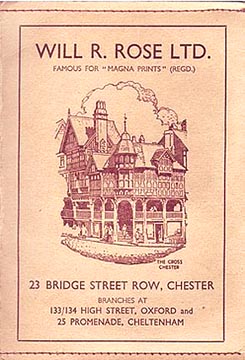 he writer and traveller John Lawson Stoddard was born in Brookline, Massachusetts in 1850. After some years teaching, in 1874 he began traveling around the world and turned his experiences into a series of popular lectures delivered throughout North America. These lectures were periodically published in book form as John L. Stoddard's Lectures. The books were immensely popular in their day and many copies still survive. In 1901 he got his first impressions of 'Old England' during a visit to Chester… he writer and traveller John Lawson Stoddard was born in Brookline, Massachusetts in 1850. After some years teaching, in 1874 he began traveling around the world and turned his experiences into a series of popular lectures delivered throughout North America. These lectures were periodically published in book form as John L. Stoddard's Lectures. The books were immensely popular in their day and many copies still survive. In 1901 he got his first impressions of 'Old England' during a visit to Chester…
"It was on a beautiful afternoon in May, soon after my first landing in Liverpool, that I caught sight of the old town of Chester on the river Dee. In the immediate foreground was a massive bridge built, by King Edward I, two hundred years before Columbus gazed upon the shores of the New World. As I look back upon it now, through a long vista lined with the more ancient monuments of Italy, Asia Minor, India, and Egypt, I wonder at the impression which this structure made upon me. But it was my first sight, then, of any genuine relic of past centuries; and the mere thought that these old arches had supported Queen Elizabeth, Charles I, Cromwell, and scores of other royal or distinguished characters gave me my first experience in realizing history, which is, perhaps, the greatest charm of foreign travel. But these impressions sank into comparative insignificance as, on our way to the hotel, we passed an ancient tower, carefully restored. Beside this monument, even the bridge of Edward I seemed modern; since this once formed a part of the old walls of Chester, and its foundations are a relic of imperial Rome. Chester was, in fact, for four hundred years, a Roman stronghold of such value that, as its name denotes, it was called simply Cas-trum, or "The Camp," - much as old Rome herself was proudly named, as if that single title were sufficient, Urbs, "The City." We cannot, therefore, be surprised to learn that in its soil coins, inscriptions, altars, and mosaic pavements have been found, all dating from the time when a word uttered on the Palatine was obeyed in Britain, and Rome was still the mistress of the world.
I know of nothing precisely like the walls of Chester. The Kremlin battlements in Moscow may suggest them; but the old Russian towers have summits almost inaccessible, while these thick walls of Chester enclose the town in one continuous ring, and form a well-paved promenade, nearly two miles in circuit and in some places forty feet in height. How stirring are the memories which they suggest! Here, for centuries, while the young Christian Church with tears and prayers was burying its martyrs in the catacombs, the soldiers of the Caesars kept their watch and ward above the town below, till the eventful day when Rome's imperial legions were called back to Italy, to ward off the alarming blows struck by barbarians at the Empire's heart. Upon the surface of one of these turrets, also, I read the inscription: "Upon this tower, Sept. 27, 1645, stood King Charles I, and saw his army defeated on Rowton Moor." For Chester ("loyal Chester", it was then called) was the first English city to declare for Charles, and the last to yield to Cromwell; and it was with the bitter consciousness that the last gem was being taken from his coronet of faithful towns, that the unhappy monarch (himself so soon to suffer death) saw from this tower his gallant cavaliers borne down by the fierce squadrons of the Puritans.
I never saw more curious architecture, even in the oldest towns of Germany, than that of some of Chester's streets. A score of times I said, regretfully, "Why did not Dickens give to these odd passageways some of his inimitable descriptions?" He, of all writers, would have fairly reveled here. Thus, some of the houses have to lean against their neighbors for support, as if too weak to stand alone, or out of breath from their long race with Time. Their very foundations seem to have shrunk away, like the limbs of a paralytic, and look as if they might collapse at any moment and let the superstructure fall.
Still more extraordinary than these, however, are Chester's covered sidewalks. Their sombre hue and well-worn steps attest their great antiquity, and it is interesting to learn that they are supposed to follow exactly the lines of the original Roman thoroughfares. They are called "Rows", but certainly not because of any perfume here of Jacqueminots. By any name they would smell no more sweetly; for musty odors haunt these low-browed corridors, and damp, unsavory smells creep out from the old planks and flagstones never gilded by the sun. Yet in these shadowy arcades are many handsome shops, above which frequently dwell the tradesmen's families. One of the houses surmounting these sidewalks has a more juvenile appearance than its neighbors, since it was reconstructed thirty years ago. Upon the sill, however, just above the corridor, I read the ancient inscription: "God's Providence is my inheritance." Is it possible that these words betray the owner's disappointment on coming into possession of this residence? Apparently he had more faith in Providence than in the value of the premises. I fancy that his sentiments must have been, "God only knows what I am going to realize from this property." A friend of mine, who had invested heavily in Western farm mortgages here turned his face to the wall and wiped away a tear. It is claimed, however, that this inscription denotes the owner's gratitude to Providence for having spared his dwelling during the ravages of the plague in Chester two hundred years ago".
  The distinguished novelist Henry James (1843-1916), was born in America but spent much of his life in Europe. This passage from his "most perfect" novel The Ambassadors (1903) is expressive of his affection for Chester and all things English- he became a naturalised Englishman just before his death. The distinguished novelist Henry James (1843-1916), was born in America but spent much of his life in Europe. This passage from his "most perfect" novel The Ambassadors (1903) is expressive of his affection for Chester and all things English- he became a naturalised Englishman just before his death.
(Oscar Wilde, however, remarked of his literary style, "Mr Henry James writes fiction as if it were a painful duty")...
"The tortuous wall-girdle, long since snapped, of the little swollen city, half held in place by careful civic hands, wanders in narrow file between parapets smoothed by peaceful generations, pausing here and there for a dismantled gate or a bridged gap, with rises and drops, steps up and steps down, queer twists, queer contacts, peeps into homely streets and under the brows of gables, views of cathedral tower and waterside fields, of huddled English town and ordered English country..."
"It is still an antique town, and medieval England sits bravely under her gables" So he wrote years before creating 'Ambassador' Strether strolling on Chester's wall, admiring the Cathedral and "the first swallows of spring".
James himself was was also inspired by the Cathedral, writing of "the vast oaken architecture of the choir stalls, climbing vainly against the dizzier reach of the columns".
 In 1903, T. A. Coward published his book Picturesque Cheshire; a glowing account of the county in the closing days of the nineteenth century.
Here are a couple of extracts dealing with the city of Chester: In 1903, T. A. Coward published his book Picturesque Cheshire; a glowing account of the county in the closing days of the nineteenth century.
Here are a couple of extracts dealing with the city of Chester:
"A mile from Hoole I enter Chester- Chester, the ancient city, capital of Cheshire and practically of North Wales; Chester, beloved by Americans; Chester, the centre of all historical interest in the County Palatine.
The men of Chester are proud of their ancient home; they love its quaint street rows, and lath and plaster buildings, its cathedral, its ruined church, its Roman baths and houses. Chester to-day, save that the streets are wider and lined with tram lines and that electric light illuminates dark corners, looks much as it did in mediaeval days. No one dare nowadays erect a plain brick building or an ugly factory within the city; the modern buildings are all half-timbered, black and white; it is not always easy at first sight to distinguish between a new shop or house and the freshly painted timbers and clean new whitewash of some timehonoured mansion.
The Rows, the raised sidewalks with shops within and shops below, for which Chester is famous, are rebuilt and repatched whenever time threatens their stability; the city walls that gird the centre of the town are kept in perfect order...
Of Chester, Lucian, the monk, wrote about the twelfth century: "And whilst it casteth an eye forward into the East; it looketh towards not only the See of Rome, and the Empire thereof, but the whole world also, so that it standeth forth as a kenning place to view of eyes, that there may be known valiant exploits, and the long train and consequence of things." "which city having gates from four cardinal winds, on the east-side hath a prospect towards India, on the west toward Ireland, north-eastward the greater Norway, and southward that straight and narrow Angle, which divine severity, by reason of civil and home discords, hath left unto the Britons."
Sleepy Chester! Looking out towards the whole world as a kenning place! Yes, perhaps; but say rather, Sleeping Chester! Chester, the city of the dead, Chester the Ancient. Older than busy, bustling Manchester; older by far than that huge city of Birmingham; a seaport whose fleets traded with the world when the great Port of Liverpool was but a handful of hovels beside the Mersey pool. A most ancient, hoary-headed city compared with your huge Metropolis, oh ye quizzical Americans! though to do you justice, you know how to appreciate its history and relics of the past.
One word more. When that ponderous lexicographer, Dr Johnson, closed his description of Chester in 1774, he remarked: "Chester has many curiosities." Indeed it has!
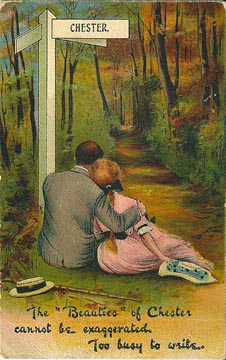  A curious news item, which appeared in the New York Times, September 13th 1913, described how a wealthy American collector, Mr Henry C Frick, had acquired, in addition to a rare 17th century organ, "some remarkable specimens of carved woodwork from a room of a house in Chester. The woodwork, which is now crossing the Atlantic, came from one of the houses in The Rows. The room it adorned was designed by Sir Christopher Wren at the request of the municipality for the city's mayor. The purchaser, Karl J Freund, a New York Dealer, who is now in Paris, feared to announce the purchase of the doors, panelling and wainscotting while the woodwork was still in England, fearing that legal means might be devised to prevent their exportation to the United States. The carvings are extraordinary. Their grace and richness are said to surpass even those of the great show-rooms at Hampton Court." A curious news item, which appeared in the New York Times, September 13th 1913, described how a wealthy American collector, Mr Henry C Frick, had acquired, in addition to a rare 17th century organ, "some remarkable specimens of carved woodwork from a room of a house in Chester. The woodwork, which is now crossing the Atlantic, came from one of the houses in The Rows. The room it adorned was designed by Sir Christopher Wren at the request of the municipality for the city's mayor. The purchaser, Karl J Freund, a New York Dealer, who is now in Paris, feared to announce the purchase of the doors, panelling and wainscotting while the woodwork was still in England, fearing that legal means might be devised to prevent their exportation to the United States. The carvings are extraordinary. Their grace and richness are said to surpass even those of the great show-rooms at Hampton Court."
Remarkable stuff. This is the first we've heard of the great Wren having designed anything in Chester. Who knows, perhaps it was merely a 'clever bit of patter', all the better to impress a 'gullible Yank' and boost the price? Should any of our American friends know of what became of the panelling, we'd love to hear about it!
 Best
remembered
for
his 'In
Search
of'
books,
the
prolific
travel
writer H. V. Morton published
his In
Search
of
England in
June
1924.
From
it,
here
is
his
evocative record
of
a
visit
to
Chester: Best
remembered
for
his 'In
Search
of'
books,
the
prolific
travel
writer H. V. Morton published
his In
Search
of
England in
June
1924.
From
it,
here
is
his
evocative record
of
a
visit
to
Chester:
"Well and truly was Chester called by the Britons Caer Lleon, the 'City of the Legions'. Chester is still the 'City of the Legions', only they now come from Louisville, and Oshkosh, New York, and Washington.
For years I have heard people decribe the wonder of a walk round the walls of Chester. Naturally the first thing I did when I arrived here was to find the wall, which is not difficult. Chester, as you must know, is the only city in England which retains its medieval wall complete: a high red sandstone walk with towers at various strategic points along its course; on one side a handrail to prevent you from falling into back gardens, on the other a waist-high barrier from which in old times the Cestrians were in the habit of defying their enemies with boiling oil-and anything else that came handy. 'Blessed is he that expecteth little ' is a wise maxim that has been drummed into me since I first sat up and wanted the moon; but I have never absorbed it. I realized this on the walls of Chester.
Any man might with justice, I think, expect that as he walked a medieval town wall something at least heroic would meet his eye, but the walls of Chester gave me only a much better idea of other people's washing, the gas-works, and the canal. You see Chester within the wall remains medieval, but Chester outside the wall is industrial. It has not been possible, with factory sites at one hundred and thirty pounds an acre, for Chester to retain a wide, open space outside the wall, and, consequently, the wall of Chester stands with its arms round beautiful old Chester, while ugly new Chester peeps over the parapet from the other side.
I had been walking for about ten minutes, admiring the small, reddy-brown cathedral
through the trees, when I came to a turret approached by a flight of ancient steps, and on the wall was this dramatic inscription:
KING CHARLES
STOOD ON THIS TOWER
SEPTEMBER 24th, 1645, AND SAW
HIS ARMY DEFEATED
ON ROWTON MOOR
Inside
the
tower
a
man
was
presiding
over
a
little
museum.
He
told
me,
just
as
though
he
was
present
at
the
time,
that
when
the
Royalist
army
was
riding
to
reinforce
the
garrison
at
Chester,
the
Roundheads
set
upon
them
and
routed
them
with
poor
King
Charles
standing
on
this
tower
watching
every
move
of
the
game.
There
are
various
battlefield
relics
in
the
museum,
also
several
Roman
antiquities
which
take
the
mind
back
to
the
days
when
that
magnificent
Legion,
the
20th,
known
as
the
'Valeria
Victrix',
was
the
crack
regiment
of
Deva.
I
had
been
walking
for
miles,
wondering
if
the
wall
of
Chester
ever
completes
its
circle,
when
I
came
to
that
which
any
exhausted
visitor
must
regard
as
a
poor
joke.
Here,
near
Bridge
Gate,
is
a
long
flight
of
steps
arranged
in
sets
of
three
and
known
as
the
'Wishing
Steps'.
'Why?'
I
asked
a
man
who
was
standing
on
them,
looking
as
though
none
of
his
wishes
had
ever
come
true.
'Well,'
he
said,
in
the
curiously
blunt
way
they
have
here,
'you
have
to
run
up
and
down
and
up
again
without
taking
breath,
and
then
they
say
you'll
get
your
wish.'
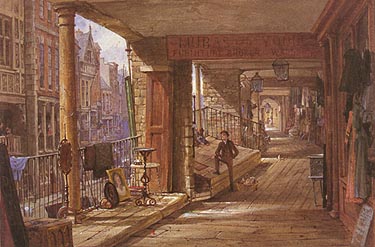 I
noticed
a
band
of
breathless
Americans
standing
on
the
other
side,
utterly
vanquished.
I
decided
to
try
no
conclusions
with
the
Wall
of
Chester
and
passed
on
in
a
superior
way,
mentally
deciding
to
have
a
wish-
for
I
can
never
resist
these
challenges
of
Fate-
some
morning
when
I
could
come
fresh
and
vigorous
to
the
steps.
That,
however,
I
learn
is
not
playing
the
game;
you
must
walk
the
wall
first
and
then
'run
up
and
down
and
up
again',
a
feat
which
I
shall
leave
to
the
natives-
and
to
the
Legions! I
noticed
a
band
of
breathless
Americans
standing
on
the
other
side,
utterly
vanquished.
I
decided
to
try
no
conclusions
with
the
Wall
of
Chester
and
passed
on
in
a
superior
way,
mentally
deciding
to
have
a
wish-
for
I
can
never
resist
these
challenges
of
Fate-
some
morning
when
I
could
come
fresh
and
vigorous
to
the
steps.
That,
however,
I
learn
is
not
playing
the
game;
you
must
walk
the
wall
first
and
then
'run
up
and
down
and
up
again',
a
feat
which
I
shall
leave
to
the
natives-
and
to
the
Legions!
There
is
one
feature
of
Chester
which,
to
my
mind,
is
worth
ten
walls.
There
is
nothing
like
it
in
any
English
town- the
Chester
'Rows'. Watergate Row North by Louise Raynor (1832-1924). You can see many more of her Chester paintings here.
Chester
is
a
town
of
balconies.
The
first
impression
I
received
of
it
was
a
town
whose
inhabitants
spend
a
great
portion
of
their
lives
leaning
over
old
oak
galleries,
smoking
and
chatting
and
watching
life
go
by
below
them
in
the
streets.*
'The
Rows'
are
simply
long,
covered
arcades
formed
by
running
a
highway
through
the
first
stories
of
a
street
of
old
buildings.
You
mount
from
the
roadway
to
'the
Rows'
on
frequent
flights
of
stone
steps
and
find
yourself
in
the
strangest
shopping
streets
in
England.
Here
are
the
best
shops
hidden
away
in
the
darkness
of
these
ancient
arcades,
and
it
is
possible
to
shop
dry-shod
in
the
worst
weather.
There
is
a
peculiar
charm
about
'the
Rows'.
They
are
not
typically
medieval,
because
there
is
no
record
of
any
other
street
of
this
kind
in
the
Middle
Ages,
yet
they
impart
a
singular
impression
of
medievalism:
through
the
oak
beams
which
support
the
galleries
you
see
black-and-white
half-timbered
houses
on
the
opposite
side
of
the
street,
with
another
'
Row'
cut
through
their
first
floors,
on
whose
balconies
people
are
leaning
and
talking
and
regarding
the
flow
of
life.
The
main
streets
of
Chester
give
you
the
impression
that
a
huge
galleon
has
come
to
anchor
there
with
easy,
leisurely
passengers
leaning
on
the
deck
rails.
This
peculiar
feature
of
Chester
has
worried
the
antiquaries
more
than
anything.
Theories
to
explain
how
and
why
these
peculiar
streets
grew
up
are
numerous
and
none
of
them
definite.
'Who
knows
why
they
are
built?'
said
a
local
antiquary.
'One
theory
is
that
the
ruins
of
the
Roman
buildings
inspired
the
architects
of
later
times.
Another
theory
is
that
the
arcades
were
formed
during
the
Middle
Ages
to
provide
street
defence
against
Welsh
raiders;
a
third
theory
explains
them
on
the
ground
that
traders
erected
their
buildings
on
the
ruins
of
the
Roman
Castrum,
the
most
valuable
ground,
naturally,
in
the
town,
and,
as
other
traders
were
attracted
to
the
same
profitable
site,
a
further
row
of
buildings
rose
up
on
the
ruins
behind
the
first,
from
which,
of
course,
it
is
but
a
step
to
a
covered
arcade
running
the
length
of
the
street.
But
no
one
can
say
with
certainty
how
they
evolved.
'The
Rows'
are
one
of
the
architectural
mysteries
of
England.
Chester
is
as
'medieval'
as
Clovelly
is
'quaint
'.
There
is
no
getting
away
from
it.
At
night
a
walk
through
'the
Rows'
is
eerie.
These
long
tunnels
are
almost
pitch
dark.
When
the
shops
are
closed
they
are
deserted,
for
the
Cestrians
then
take
to
the
normal
roadway,
and
you
can
walk
on
and
on
along
this
ancient
highway,
through
colonnades
upheld
by
vast
oak
beams,
half-expecing
to
hear
the
scuffle
of
hired
assassins
and
the
gasp
of
a
man
with
a
dagger
in
his
neck.
I
have
yet
to
meet
a
more
dramatic
street.
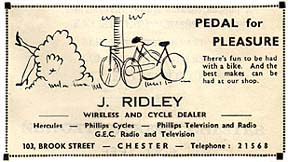 Chester
is
so
accustomed
to
ancient
things
that
no
one
considered
it
strange
to
drink
coffee
in
a
twelfth-century
crypt.
There
is
a
beautiful
vaulted
crypt
which
has
been
converted
into
a
restaurant!
(still
thriving
today,
in
Eastgate
Street.
Ed)
I
went
there
and
sat
utterly
crushed
by
my
surroundings.
I
looked
round
for
the
monks,
but
saw
only
young
men
and
women,
taking,
so
it
seemed,
sacrilegious
sips
of
tea
and
eating
cream
cakes. Chester
is
so
accustomed
to
ancient
things
that
no
one
considered
it
strange
to
drink
coffee
in
a
twelfth-century
crypt.
There
is
a
beautiful
vaulted
crypt
which
has
been
converted
into
a
restaurant!
(still
thriving
today,
in
Eastgate
Street.
Ed)
I
went
there
and
sat
utterly
crushed
by
my
surroundings.
I
looked
round
for
the
monks,
but
saw
only
young
men
and
women,
taking,
so
it
seemed,
sacrilegious
sips
of
tea
and
eating
cream
cakes.
One
of
the
happiest
memories
of
my
search
will
be
the
recollection
of
the
many,
times
I
have
hung
out
of
hotel
and
inn
windows
before
going
to
bed
listening
to
the
night
sounds
of
towns
and
cities
and
villages.
I
must
write
a
story
about
them
some
day.
At
night,
when
the
tramcars
have
stopped
running
and
the
crowds
have
gone
home,
and
the
last
American
has
drunk
the
last
'highball'
in
the
smokeroom,
ancient
cities
like
Chester
come
most
vividly
to
life.
So
you
must
leave
me
in
Chester,
under
a
big
round
moon,
leaning
out
in
the
soft
coolness
of
the
night,
watching
the
Valeria
Victrix
stack
spears
in
the
main
street,
and
stand
back
waiting
for
orders
to
found
one
of
the
oldest
cities
in
England.
And
it
was
on
the
'Holy
Dee',
the
broad,
slow
river
that
winds
itself
round
Chester,
that
King
Edgar
in
973
gave
away
his
character
to
posterity
by
being
rowed
in
his
barge
by
tributary
princes,
And
it
was
in
Chester...
I
could
go
on
through
history
picking
out
little
pictures
of
Chester;
but
it
is
so
late,
and
the
moon
is
riding
high
above
this
silent
city,
where
old
houses
dream
across
old
streets
with
their
roots
among
the
little
red
tiles
of
Rome.
* Over
a
century
before
these
words
were
written-
in October
1811,
to
be
exact-
the Chester
Courant portrayed
a
rather
different
impression
of
the
younger
citzens
who
spent
their
leisure
hours
on
the
Rows:
"The
gangs
of
blackguards
which,
during
the
Winter
season,
infest
the
Rows
of
this
city,
have
commenced
their
nocturnal
outrages. The
south
Row
of
Eastgate
Street
is
the
general
rendevous,
where
they
parade
or
sit
in
groups,
interrupting
the
passage,
or
insulting
everyone
that
passes,
particularly
females,
who
are
perpetually
annoyed
by
their
rude
insults".
 Some extracts from the Chester chapter of the 1935 (6th) edition of Dora Benson's British Holidays in North Wales: Some extracts from the Chester chapter of the 1935 (6th) edition of Dora Benson's British Holidays in North Wales:
 "The unique characteristics which baffle the descriptive writer, and even the artist, are the most powerful reasons for inducing the visitor to spend a few days in Chester. It is a city where evidences of its antiquity meet the eye on every side. The fine circuit of its Roman Walls, its beautiful cathedral and monastic buildings, its main streets with their half-timbered medieval houses and unique Rows, the old bridge across the lovely river Dee- all these combine to endear it to the student of English architecture and the lover of the picturesque. "The unique characteristics which baffle the descriptive writer, and even the artist, are the most powerful reasons for inducing the visitor to spend a few days in Chester. It is a city where evidences of its antiquity meet the eye on every side. The fine circuit of its Roman Walls, its beautiful cathedral and monastic buildings, its main streets with their half-timbered medieval houses and unique Rows, the old bridge across the lovely river Dee- all these combine to endear it to the student of English architecture and the lover of the picturesque.
In addition to these signs of a long history, are the remains of the Roman fortress of Deva. There is no street, hardly a stone, in this wonderful old city that does not stir the imagination and give memory a thrill.
The most recent discovery of importance is a Roman Legionary amphitheatre, which, although not yet excavated, is believed by experts to be the largest in the British Isles and among the largest in the world.
For all its old-world charm, Chester is modern with modern attractions, and first and foremost among them are the shops. Even apart from their medieval setting, these merit the admiration of visitors; but only those who have experience of the Rows can appreciate how convenient for shopping is that wonderful survival of the Middle Ages which Chester, alone of all the cities in the world, possesses. There are plenty of good hotels; cafes and restaurants are to be found in all the principal streets; there are central garage facilities for an unlimited number of cars, while the corporation has provided no less than four public parking grounds in central positions. Easy access to all parts of the city and suburbs is afforded by up-to-date motor omnibuses.
As a motoring centre, Chester is worthy of attention even by those who have not a private car. It is, moreover, the Gateway to North Wales. The splendidly organized transport services of the district provide an easy means of reaching places of interest, and special tours to the most famous beauty-spots are run very frequently throughout the season.
The walls, which completely encircle the city, are built upon foundations which, in many parts, are undoubtedly Roman; and although the superstructure, in course of time, has been to a large extent renewed, it is nevertheless of great age. The four main gates stand, roughly, at the four points of the compass, and there is also a smaller gate called the Newgate or Peppergate (16th-century) on the south-east. An additional and large Newgate is now under construction to provide for modern traffic requirements.
 A continuous promenade of nearly two miles, with delightful views of mountain and river and green meadow, runs along the top of the walls for the complete circuit, and affords a unique experience. A continuous promenade of nearly two miles, with delightful views of mountain and river and green meadow, runs along the top of the walls for the complete circuit, and affords a unique experience.
The medieval appearance of the Chester streets is due to the large number of fine half-timbered houses, and to the Rows. These Rows are a remarkable feature of the City's architecture and are unique. Their special characteristic is the double row of shops, one at street level and the other at first floor level, while the covered footway of the Rows proper provides a continuous thoroughfare for pedestrians on the upper level. The footway of the Rows is in addition to the ordinary footway at street level and is connected thereto by frequent flights of steps.
Right: "Discover, Enjoy, Chester": a German cigarette advertisment
The Rows do not look directly down to the street, but have a series of stalls or balconies between the footway and that of the street, which provides a convenient space for the shopkeeper to display his wares. The origin of the Rows is lost in obscurity, but there can be no question about their suitability as a fashionable promenade. Ladies especially will appreciate, when shopping, the shelter they afford in all weathers.
Probably no other city enjoys such a beautiful river frontage. The most beautiful part of all extends from the Old Dee Bridge eastwards as far as Grosvenor Park, and is known as The Groves. Facing south, it enjoys the maximum of sunshine, and on many a winter's day its temperature is almost sultry. In summer the multitude of boats on the river add to the gaiety of the scene. Boating on the Dee is one of the happiest experiences which Chester has to offer.
The visitor seeking a little relaxation will find a good entertainment at the Royalty Theatre (City Road- Stage plays and Varieties); the Gaumont Palace Super Cinema, Brook Street; the Music Hall Cinema, Northgate Street; the Majestic Cinema, Brook Street; and the Park Cinema, Saltney. New super cinemas under construction: Odeon, Market Square; A.B.C., Foregate Street and also News Cinema, Foregate Street.
Of all of the above 'places of relaxation' of seventy years ago, only the Odeon in Market Square survived- until it was disgracefully closed down in 2007 (and remains so in 2014)...
 In
1939,
in
his Life
of
Dickens, Graham
Laud wrote: In
1939,
in
his Life
of
Dickens, Graham
Laud wrote:
"Chester
is
a
glorious
ancient
city
with
a
rare
elegance
in
its
beautifully
preserved
old
buildings.
A
sense
that
all
England's
history
is
encapsulated
here
in
its
broad,
cobbled,
enchanting
streets
and
from
its
2000
year
old
walls
to
the
awesome
cathedral.
Yet
it
is
surprisingly
young
and
lively.
A
living
city
with
a
zing
in
the
air,
yet
mature
and
relaxed,
a
city
that
knows
itself
to
be
happy
in
its
skin.
This
is
the
city
I
grew
up
in
and
loved".
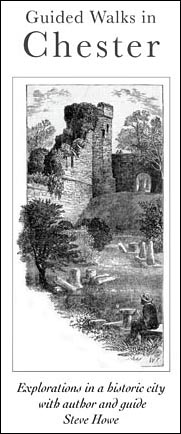  Published
in
1958, T.
H.
White's great
novel The
Once
and
Future
King is
a
wonderfully
witty
and
moving
re-telling
of
the
Arthurian
legend.
It
contains
some
evocative
descriptions
of
life
in
medieval
towns,
including
this
passage
where
the
King
and
his
party
arrive
at Carlion-
(the
Saxon
name
for
Chester
was Caerlion and
our
Welsh-speaking
neighbours
to
this
day
refer
to
the
city
as Caer)-
for
a
wedding: Published
in
1958, T.
H.
White's great
novel The
Once
and
Future
King is
a
wonderfully
witty
and
moving
re-telling
of
the
Arthurian
legend.
It
contains
some
evocative
descriptions
of
life
in
medieval
towns,
including
this
passage
where
the
King
and
his
party
arrive
at Carlion-
(the
Saxon
name
for
Chester
was Caerlion and
our
Welsh-speaking
neighbours
to
this
day
refer
to
the
city
as Caer)-
for
a
wedding:
"The
metropolitan
glories
of
Carlion
were
enough
to
take
their
breaths
away.
Here,
round
the
King's
castle,
there
were
streets-
not
just
one
street-
and
castles
of
dependent
barons,
and
monasteries
and
chapels,
churches,
cathedrals,
markets,
merchant's
houses.
There
were
hundreds
of
people
in
the
streets,
all
dressed
in
blue
or
red
or
green
or
any
bright
colour,
with
shopping
baskets
over
their
arms,
or
driving
hissing
geese
before
them,
or
hurrying
hither
and
thither
in
the
livery
of
some
great
lord.
There
were
bells
ringing,
clocks
smiting
in
belfries,
standards
floating-
until
the
whole
air
above
them
seemed
to
be
alive.
There
were
dogs
and
donkeys
and
palfries
and
farm
wagons-
whose
wheels
creaked
like
the
Day
of
Judgement-
and
booths
which
sold
gilt
gingerbread,
and
shops
where
the
finest
bits
of
of
armour
in
the
very
latest
fashions
were
displayed.
There
were
silk
merchants
and
jewellers.
The
shops
had
painted
trade
signs
hung
over
them,
like
the
inn
signs
which
we
have
today.
There
were
servitors
carousing
outside
wine
shops,
and
old
ladies
haggling
over
eggs,
and
itinerant
cads
carrying
cages
of
hawks
for
sale,
and
portly
aldermen
with
gold
chains,
and
brown
ploughmen
with
hardly
any
clothes
on
except
a
few
bits
of
leather,
and
leashes
of
greyhounds,
and
strange
eastern
men
selling
parrots,
and
pretty
ladies
mincing
along
in
high
dunce's
caps
with
veils
floating
from
the
top
of
them,
and
perhaps
a
page
in
front
of
the
lady,
carrying
a
prayer
book,
if
she
was
going
to
church.
Carlion
was
a walled town,
so
that
this
excitement
was
surrounded
by
a
battlement
which
seemed
to
go
on
for
ever
and
ever.
The
wall
had
towers
every
two
hundred
yards,
and
four
great
gates
as
well.
When
you
were
approaching
the
town
from
across
the
plain,
you
could
see
the
castle
keeps
and
church
spires
springing
out
of
the
wall
in
a
clump-
like
flowers
growing
in
a
pot".
* Robert
Stoker, in
his
book The
Legacy
of
Arthur's
Chester (1963),
pointed
out
that
there
were
actually two cities
bearing
the
name
Caerleon,
and,
after
the
departure
of
the
Legions,
it
was
here,
Caerleon-upon-Dee
that
became
the
ecclesiastical
and
civil
capital
of
the
Kings
of
Britain,
Capital
of
Wales,
GHQ
of
the
centuries-long
campaigns
against
the
Saxons
and
the
city
of
the
coronation,
in
the
early
seventh
century,
of
a
not-so-legendary King
Arthur- not Caerleon-on-Usk
(Roman Isca)
in
South
Wales.
The
confusion
seemingly
lay
with
Arthur's
medieval
chronicler, Geoffrey
of
Monmouth,
whose
patron,
Robert
of
Gloucester,
was
Lord
of
the
Monmouth
Marches,
where
Caerleon-on-Usk
is
situated.
It
seems
that
Geoffrey,
doubtess
partly
in
order
to
please
his
Lord,
attributed
all
references
dealing
with
'Caerleon-ar-Dour'
(Chester)
to
'Caerleon'
without
qualifying
which
one
the
old
chronicles
were
referring
to.
Consequently,
Stoker
claims,
historians
have
ever
since
been
crediting,
for
example,
Isca
with
having
an
archbishop
since
AD180
because
a
local
boy
in
Monmouth
had
said
so
nine
hundred
years
later...
Whatever
the
case,
think
of
the
still-magnificent
old
fortress
when
you
go here to
read
Geoffrey's
description
of
the
coronation
of
King
Arthur).
 "I
was
taken
by
your
city
walls,
but
found
Chester
a
city
where
it
was
easier
to
buy
a
crystal
or
a
packet
of
pot-pourri
than
a
pint
of
milk..." "I
was
taken
by
your
city
walls,
but
found
Chester
a
city
where
it
was
easier
to
buy
a
crystal
or
a
packet
of
pot-pourri
than
a
pint
of
milk..."
 Graham
Norton: BBC
Radio
4's
'Just
a
Minute',
recorded
at
the
Gateway
Theatre,
Chester,
February
7th
2000 Graham
Norton: BBC
Radio
4's
'Just
a
Minute',
recorded
at
the
Gateway
Theatre,
Chester,
February
7th
2000
  It's difficult to imagine now, but there was a time when major pop groups regularly performed in Chester. The Rolling Stones, for example, played at the Royalty Theatre in April 1964 and at the ABC Cinema along with Inez & Charlie Foxx in September of the same year. In October 1965, they played the ABC again, accompanied by the Moody Blues and the Spencer Davis Group. It's difficult to imagine now, but there was a time when major pop groups regularly performed in Chester. The Rolling Stones, for example, played at the Royalty Theatre in April 1964 and at the ABC Cinema along with Inez & Charlie Foxx in September of the same year. In October 1965, they played the ABC again, accompanied by the Moody Blues and the Spencer Davis Group.
Mick Jagger recalled the surreal end to the September 1964 gig. The band had to escape along the rooftops after the show because the venue was surrounded by screaming teenage fans. “I remember we had a lady pianist with us also, who was one of the opening acts, I forgot her name and she was a concert pianist and it was quite funny.”
Keith Richards recalled the same Chester gig: “One time in Chester, we have the Chief Constable of Cheshire with us in full regalia with the ribbons and the medals and the swagger stick. Show’s finished earlier than he expects. The whole theatre is surrounded. Mayhem. Maniac teenage girls, bless their hearts.
"Right," he says. "The only way out, up the stairs, over the rooftops, I know the way!". Suddenly you’re in his hands. So we get up on the Chester rooftops, and it’s raining. The first thing that happens is the Chief Constable almost slides off the roof. A couple of his bobbies managed to hold him up. We’re standing in the middle of this rooftop saying: "I’m not too familiar with this area, where do we go?"
“He pulls himself together, and in a shambolic sort of way, they manage to get us down through a skylight and out of a laundry chute, or something. That was what happened every day, and you took it as normal. Everything was a Goon Show.”
Keith repeated the story in his autobiography: " I remember once in Chester, after a show that had ended in a riot, following the Chief Constable of Chester Police over the rooftops of Chester city as in some weird Walt Disney film, with the rest of the band behind me and him in full uniform, with a constable at his side. And then he loses his fucking way, and we are perched on the top of Chester city while his great " Escape From Colditz plan diintegrates..."
 John Lennon was a frequent visitor to Chester. His sister, Julia Baird, recalled, "During childhood, John and I used to spend a lot of time in Chester. We also used to come to Chester on the train from Liverpool as we always knew that Chester was the best place for clothes shopping. We used to go for lunch at Brown's and walk down by the river. Chester has always been in the family. We are the classic family that moved from Wales to Chester to Liverpool. John was very fond of Chester. We always thought Chester was the place to be, not Liverpool." John and Julia's grandmother, Annie Jane Millward, was born at the Bear and Billet Inn in Lower Bridge Street in 1873 and lived there until she was in her 20s. According to Julia, who was a longtime former Chester resident, "Our great-grandfather (John Denbry Millward) and great-grandmother (Mary Elizabeth Millward nee Morris) lived there. Our great-grandfather was the clerk to the Earl of Shrewsbury, because of that he had the freedom to the city of Chester". John Lennon was a frequent visitor to Chester. His sister, Julia Baird, recalled, "During childhood, John and I used to spend a lot of time in Chester. We also used to come to Chester on the train from Liverpool as we always knew that Chester was the best place for clothes shopping. We used to go for lunch at Brown's and walk down by the river. Chester has always been in the family. We are the classic family that moved from Wales to Chester to Liverpool. John was very fond of Chester. We always thought Chester was the place to be, not Liverpool." John and Julia's grandmother, Annie Jane Millward, was born at the Bear and Billet Inn in Lower Bridge Street in 1873 and lived there until she was in her 20s. According to Julia, who was a longtime former Chester resident, "Our great-grandfather (John Denbry Millward) and great-grandmother (Mary Elizabeth Millward nee Morris) lived there. Our great-grandfather was the clerk to the Earl of Shrewsbury, because of that he had the freedom to the city of Chester".
Annie married George Ernest Stanley, had seven children (the first two died in infancy) - one of whom was John's mother Julia. She died in 1941.
John later returned to Chester- as a Beatle- and the band played here several times at the Riverpark Ballroom on Union Street and the Royalty Theatre in City Road. Neither of these venues exist today- bank offices stand on the site of the Riverpark and a cheap hotel on that of the poor old Royalty.
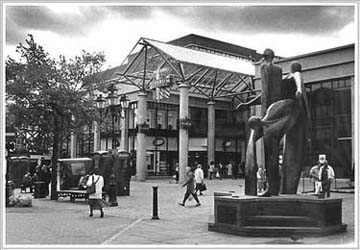  In
March
2001,
national
UK
newspaper The Independent published
a
free
supplement
entitled "Best
of
Chester:
the
Top
50
Places
to
go
in
Chester",
penned
by 'local
girl' Lucy
Gilmore. In
March
2001,
national
UK
newspaper The Independent published
a
free
supplement
entitled "Best
of
Chester:
the
Top
50
Places
to
go
in
Chester",
penned
by 'local
girl' Lucy
Gilmore.
Ms
Gilmore
succeeded
in
producing
a
minor
stink
within
the
city's
tourism
and
publicity
departments
as
a
result
of
her
reference
to
the
covered
market
as, "Originally
atmospheric,
the
entrance
is
now
through
a
tacky
shopping
centre".
This
'tacky
shopping
centre'
actually
being
the
ironically-entitled Forum (illustrated
left-
swathes
of
unique
Roman and
later
remains
were
bulldozed
during
its
construction)-
and
this
despite
its
being
only
recently
tarted-up
courtesy
of
the
Scottish
Widows
insurance
company.
The Forum's
high
point
(and
undoubted
source
of
greatest
public
ridicule)
was
surely
achieved
when,
despite
a
public
outcry,
a
branch
of McDonald's was
opened
there (on
the
far
right
hand
side
of
our
photograph)-
immediately
next
to
the
splendid
Victorian Town
Hall and
facing
the
west
front
of
the
great
medieval Cathedral...
Subsequent to the article's publication, correspondents
to
the
local
press
seemed
to
be in agreement
with
Ms
Gilmore; "Yes,
the
Forum
is
very
tacky!", "I
can't
think
of
a
better
description
of
it",
etc.
(To
see
if
you
agree
with
them,
take
a
look
at
our
feature, When
bad
things
happen
to
good
cities:
the
changing
face
of
the Chester
Market
Hall )
The
above
aside, The
Best
of
Chester contained
further
howlers-
albeit
no
more
than
many
other
'visitor's
guides'
to
our
fair
city.
The
above
referred
to
Market
Hall
was
said
to
feature
"strapping
stallholders
singing
Jerusalem
as
you
sample
ripe
Stilton
Vintage".
We're
told
that
he
Emperor
Hadrian
wanted
fortress Deva (the
city
of
Chester
as
such
not
existing
for
hundreds
more
years)
"to
reflect
the
glory
of
Rome"
and
that
the
ancient Boot
Inn in
Eastgate
Row
"has
a
skittle
alley
at
the
entrance"... We wish it still did- it's been gone for years. But it's a nice pub- with possibly the best value pint in town- nontheless...
The
exhibitions
said
to
be
held
in
the
Summer
in
the Water
Tower and Phoenix
Tower have
not
been
seen
for
several
years,
the
city
council
having closed these
most attractive and interesting
places
in
order
to
save
a
few
pounds-
and
the
excellent Toy
Museum in
Lower
Bridge
Street
was
praised,
despite
its
having being
forced
into
closure
due
to
falling
visitor
numbers
and
rising
city
centre
rent
and
rates.
It
was
ironic
indeed
to
see
the
city's
main
commercial
competitor
and
arch-rival,
the
newly-developed Cheshire
Oaks
Designer
Outlet
Village ("free
parking!")
being
listed
as number
5 of
the
"50
best
places
to
go
in
Chester"!
(We
later
heard
a rumour that Cheshire
Oaks themselves
were
not
too
pleased
about
being
so
described!)
Our
favourite,
however,
was
back
in
the Best
of
Chester's introduction,
where
we
learned
that
"Cestrians,
as
the
inhabitants
of
Chester
are
known,
have
been
welcoming
visitors
for
more
than
2,000
years-
the
Roman
invasion,
the
Norman
invasion,
the
Civil
War..."
To
apply
the
term
'welcoming'
to
those
citizens
who
were
slaughtered,
enslaved,
starved
or
made
homeless
during
centuries
of
military
conflict
and
bloody
siege
was,
we
thought,
even
for
journalism
of
this
standard,
stretching
it
a
bit...
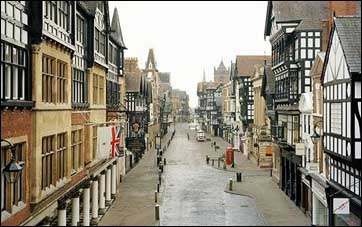  One Mick Brown of the Daily Telegraph rolled into Chester and penned a deeply flawed and rather depressing article about the state of the city's trade (and comparing it unfavourably with Totnes in Devon), which was published on Saturday 13th June 2009: Financial Crisis: High Noon on the High Street. One Mick Brown of the Daily Telegraph rolled into Chester and penned a deeply flawed and rather depressing article about the state of the city's trade (and comparing it unfavourably with Totnes in Devon), which was published on Saturday 13th June 2009: Financial Crisis: High Noon on the High Street.
As may be seen here, a photograph of Eastgate Street that headed this dodgy piece of pseudo-journalism was remarkable in that there is not a single soul to be seen- somebody must have had to get up very early in the morning to get that, obviously in a malicious attempt to give the false impression that Chester has become some sort of commercial ghost town.
We don't know much about the Telegraph's usual way of doing things but this struck us as pretty shabby, gutter press stuff.
 Many generations of students have come to Chester to study- and much else! Here are two hilarious- and previously unpublished- true stories by Simon Catterall: Youthful memories of Chester (1974) and Naked Around the Walls! (1984) Many generations of students have come to Chester to study- and much else! Here are two hilarious- and previously unpublished- true stories by Simon Catterall: Youthful memories of Chester (1974) and Naked Around the Walls! (1984)
 Written by journalist Tom Dyckhoff, this article, which appeared in The Guardian, Saturday 6th December 2008, contains some interesting impressions of the city as seen with a distincly middle-class slant- and also some telling comments from locals-
Let's move to Chester. Written by journalist Tom Dyckhoff, this article, which appeared in The Guardian, Saturday 6th December 2008, contains some interesting impressions of the city as seen with a distincly middle-class slant- and also some telling comments from locals-
Let's move to Chester.
 This satirical little poem, penned by distinguished Chester author and historian Gordon Emery, appeared in the local press in October 2009: This satirical little poem, penned by distinguished Chester author and historian Gordon Emery, appeared in the local press in October 2009:
We voted in the Tories to help mend the wall
But soon a large section began to fall.
With sycamore trees and empty towers
At least we had some ragwort flowers.
The glass slug gone, we wept for joy
Till the Tories bought a new glass toy
Just 20 million - we won’t pay rent
Are the lovely glass walls all that is bent?
Cinema’s gone, theatre too
Nothing for the many, a lot for the few
Chester History & Heritage soon to be shut
Just to pay for council glut.
The council offices meant for the slug
Are now going into a giant glass plug
But please don’t worry, please don’t mope
We’re going to be a City of Culture
- some hope! |
 And this very pertinent little piece, responding to the recent erection of some very regrettable buildings- and ludicrous grand plans for more of the same- in our fair city, was recently posted on the (sadly now defunct) Chester@Large City Forum: And this very pertinent little piece, responding to the recent erection of some very regrettable buildings- and ludicrous grand plans for more of the same- in our fair city, was recently posted on the (sadly now defunct) Chester@Large City Forum:
"It appears that many within the planning department of Chester City Council are maybe under the delusion that they are building a new town and, consequently, have attempted to fulfil the following criteria in keeping with new town development,
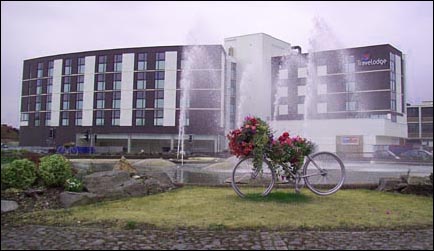 1) City Council planners must pass an IQ test in order to ensure that they achieve a score no greater than 70. 1) City Council planners must pass an IQ test in order to ensure that they achieve a score no greater than 70.
2) Building must be sporadic with no plan whatsoever.
3) Buildings have to look as ugly as possible. Attractive, historic, and characterful buildings will be demolished to make way for buildings which are in keeping with the vision set forth by Chester City planners.
4) If there exists a free space in the city, build on it.
5) Ignore all and any Roman and historic remains because that's in the past and doesn't count. Historical remains will be counted as "free space".
6) CC planners not accompanied by a guide dog will not be permitted to work within Chester.
 An old Welsh proverb, said of getting something done early, was "before the dogs of Chester begin to bark". An old Welsh proverb, said of getting something done early, was "before the dogs of Chester begin to bark".
 Still in Wales, we conclude our collection of quotes from Chester's visitors through the ages with this old nursery song, popular for generations with Welsh children. It was recorded by Owen M Edwards in his Hwiangerddi (Nursery Rhymes) in 1911: Still in Wales, we conclude our collection of quotes from Chester's visitors through the ages with this old nursery song, popular for generations with Welsh children. It was recorded by Owen M Edwards in his Hwiangerddi (Nursery Rhymes) in 1911:
Gyrru, gyrru, gyrru i Gaer,
I briodi merch y Maer;
Gyrru, gyrru, gyrru i adre,
Wedi priodi ers diwrnodie.
"Ride and ride and ride to Chester,
There to wed the Mayor's daughter;
Ride, ride home and ride heigh-ho,
Having wedded days ago". |
|
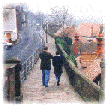




 I
noticed
a
band
of
breathless
Americans
standing
on
the
other
side,
utterly
vanquished.
I
decided
to
try
no
conclusions
with
the
Wall
of
Chester
and
passed
on
in
a
superior
way,
mentally
deciding
to
have
a
wish-
for
I
can
never
resist
these
challenges
of
Fate-
some
morning
when
I
could
come
fresh
and
vigorous
to
the
steps.
That,
however,
I
learn
is
not
playing
the
game;
you
must
walk
the
wall
first
and
then
'run
up
and
down
and
up
again',
a
feat
which
I
shall
leave
to
the
natives-
and
to
the
Legions!
I
noticed
a
band
of
breathless
Americans
standing
on
the
other
side,
utterly
vanquished.
I
decided
to
try
no
conclusions
with
the
Wall
of
Chester
and
passed
on
in
a
superior
way,
mentally
deciding
to
have
a
wish-
for
I
can
never
resist
these
challenges
of
Fate-
some
morning
when
I
could
come
fresh
and
vigorous
to
the
steps.
That,
however,
I
learn
is
not
playing
the
game;
you
must
walk
the
wall
first
and
then
'run
up
and
down
and
up
again',
a
feat
which
I
shall
leave
to
the
natives-
and
to
the
Legions!  Chester
is
so
accustomed
to
ancient
things
that
no
one
considered
it
strange
to
drink
coffee
in
a
twelfth-century
crypt.
There
is
a
beautiful
vaulted
crypt
which
has
been
converted
into
a
restaurant!
(still
thriving
today,
in
Eastgate
Street.
Ed)
I
went
there
and
sat
utterly
crushed
by
my
surroundings.
I
looked
round
for
the
monks,
but
saw
only
young
men
and
women,
taking,
so
it
seemed,
sacrilegious
sips
of
tea
and
eating
cream
cakes.
Chester
is
so
accustomed
to
ancient
things
that
no
one
considered
it
strange
to
drink
coffee
in
a
twelfth-century
crypt.
There
is
a
beautiful
vaulted
crypt
which
has
been
converted
into
a
restaurant!
(still
thriving
today,
in
Eastgate
Street.
Ed)
I
went
there
and
sat
utterly
crushed
by
my
surroundings.
I
looked
round
for
the
monks,
but
saw
only
young
men
and
women,
taking,
so
it
seemed,
sacrilegious
sips
of
tea
and
eating
cream
cakes. "The unique characteristics which baffle the descriptive writer, and even the artist, are the most powerful reasons for inducing the visitor to spend a few days in Chester. It is a city where evidences of its antiquity meet the eye on every side. The fine circuit of its Roman Walls, its beautiful cathedral and monastic buildings, its main streets with their half-timbered medieval houses and unique Rows, the old
"The unique characteristics which baffle the descriptive writer, and even the artist, are the most powerful reasons for inducing the visitor to spend a few days in Chester. It is a city where evidences of its antiquity meet the eye on every side. The fine circuit of its Roman Walls, its beautiful cathedral and monastic buildings, its main streets with their half-timbered medieval houses and unique Rows, the old  A continuous promenade of nearly two miles, with delightful views of mountain and river and green meadow, runs along the top of the walls for the complete circuit, and affords a unique experience.
A continuous promenade of nearly two miles, with delightful views of mountain and river and green meadow, runs along the top of the walls for the complete circuit, and affords a unique experience.



 1) City Council planners must pass an IQ test in order to ensure that they achieve a score no greater than 70.
1) City Council planners must pass an IQ test in order to ensure that they achieve a score no greater than 70.